Why does oil calm troubled waters? That question has long piqued peoples’ curiosity. Today, we know the answer, but the phenomenon puzzled scientists for centuries.
It certainly intrigued people in the ancient world. Two thousand years ago, writers like Pliny the Elder (the Roman scholar and statesman) noted that divers sometimes took to the sea with a mouth full of olive oil, which they’d release bit by bit to calm the waves above them. Apparently, they did that so the sun would shine more steadily through the water and help them see.
Oil and water won’t mix, at least not for long under most circumstances. That’s because of the way oil and water molecules are composed. All molecules are made of atoms, and atoms have different electrical charges. They can be positive, negative or neutral. Those charges effect the way molecules behave.
Water is made up of an oxygen atom and two hydrogen atoms (which is why water is sometimes called H2O), and it’s what’s called a polar molecule. In a nutshell, that means that it has different electrical charges at each of its ends. The oxygen atom has a negative charge, whereas the two hydrogen atoms have positive ones.
Oil molecules are different. They’re usually made up of nonpolar chains of carbon, oxygen and hydrogen atoms, which are linked in ways that spread the positive and negative charges out evenly.
The upshot of all that is that water molecules are more attracted to each other than they are to oil molecules, and oil molecules are the same. They like to stick together. If you’ve ever tried to wash grease off a skillet without using soap, you’ll have experienced that first hand.
But how does that help us explain why oil can still waves?
The answer has a lot to do with density. Oil molecules are larger than water molecules. They can’t press together as tightly as water molecules. That’s why when oil and water separate, the oil rises to the top. Once at the top, the chains that make up oil molecules link together, forming a film over the water’s surface. If given enough room, that film will stretch out as far as the linked chains will let it, which is why even a teaspoon of oil can form a slick that’ll cover dozens of square feet. That’s why the divers Pliny described carried olive oil with them when they went to work.
We wouldn’t have such a firm grasp of molecular forces if it weren’t for inventions like the electron microscope. In the days before scientists had such tools, studying the interaction of oil and water was a practical way of investigating the way molecules behave and understanding their science. And questions about the interaction of oil and water were of great interest to one of the leading scientists of the 18th century, the American founding father, Benjamin Franklin.
Franklin got interested in the subject while on board a ship. He was travelling in a fleet, and he noticed that the water around two of the ships was much calmer than around the others. When he asked his captain why, he was told that the ships’ cooks had just tipped the ‘greasy water’ out of their pots and pans.
Franklin was intrigued by this explanation. It put him in mind of the divers Pliny had described, and he set out to study the phenomenon himself. He even ended up conducting an experiment that involved pouring oil into Derwent Water, in the English Lake District.
But why was Franklin in the English Lake District? Wasn’t he one of the founding fathers of the United States?
He was, but he also spent a good deal of his life in England working as a political representative. You can actually visit the townhouse where he lived in London. It’s now the Benjamin Franklin House museum. London, in Franklin’s day, was one of the world’s great centres of scientific research. It was a place where groups, like the Royal Society, were shedding new light on the forces of nature.
The Royal Society’s members knew of Franklin’s work. He was already a distinguished researcher in his own right, not least for his studies of electricity. He performed his famous kite-experiment in 1752, and he received the Society’s most prestigious award, the Copley Medal, the following year. He became a fellow of the Society in 1756.
Franklin was busy during his years in London, but he still found time to take short breaks. Sometimes, he went on trips with his friend, Sir John Pringle, who was also a fellow of the Royal Society.
It was John Pringle who arranged Franklin’s visit to the Lakes, where they called on another Royal Society Fellow, Dr William Brownrigg, who lived near Keswick. Brownrigg shared Franklin’s interest in molecular forces, and he also knew of Pliny’s description of the divers. So, one afternoon, they rowed out onto Derwent Water to see what would happen if they dropped a little oil in the lake. The experiment proved a success. In a letter Franklin wrote, he explained that the water had been ‘in great agitation’ but ‘was instantly calmed’ to a ‘great distance about the boat’ at the application of ‘only a very small quantity of oil’.
We hasten to add, of course, that Franklin wasn’t using petrol. He was likely using olive oil, which is far less hazardous. Still, we’d urge you not to recreate his experiment on your own without using proper containment equipment and checking with the appropriate authorities. The rate at which relatively benign fluids like olive oil can spread reminds us of how quickly contaminants can disperse into our water systems.
Franklin repeated his experiment on a few other occasions, and the results helped him form a theory that went on to make waves of its own. His ideas about the interaction of oil and water helped pave the way for the scientific innovations on which our knowledge of molecular physics is based. As with so many of Franklin’s contributions to the sciences, his oil on water experiment still remains very relevant to this day.







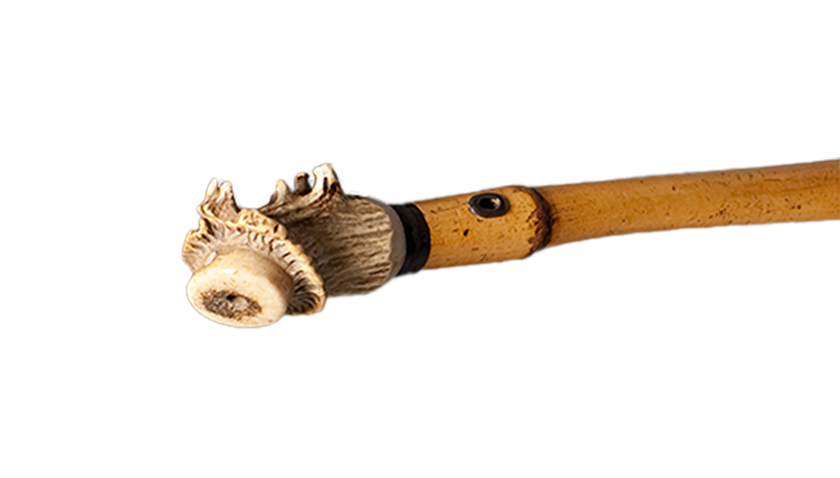
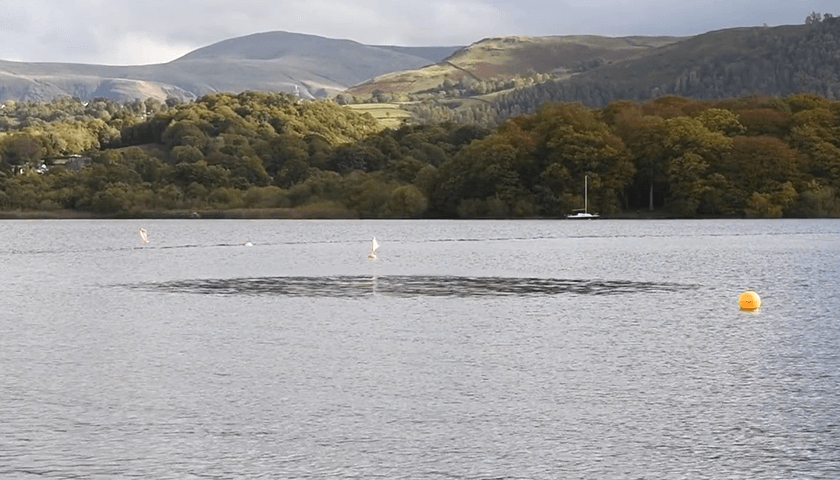
.jpeg)


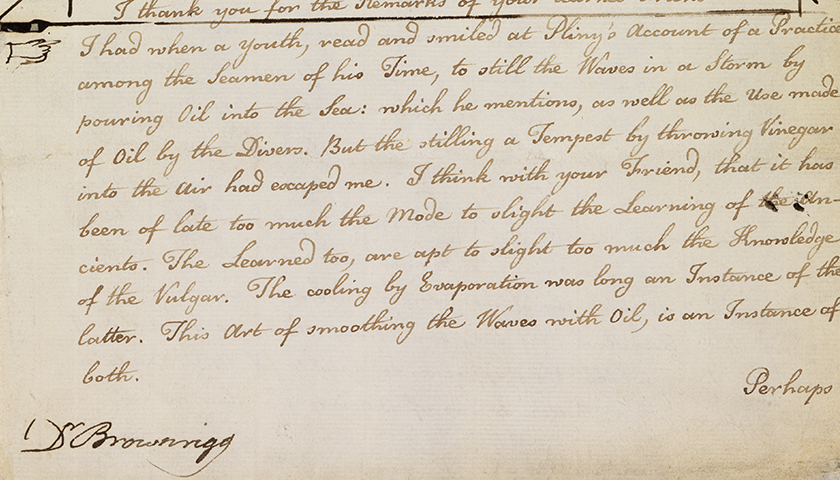
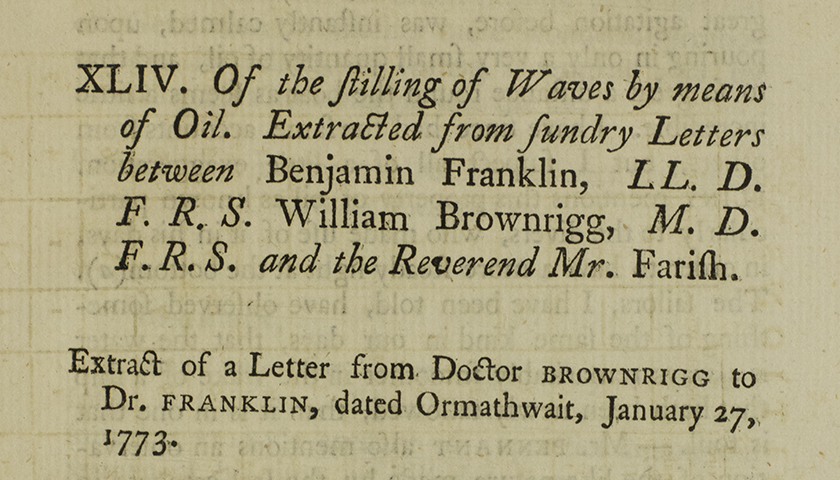

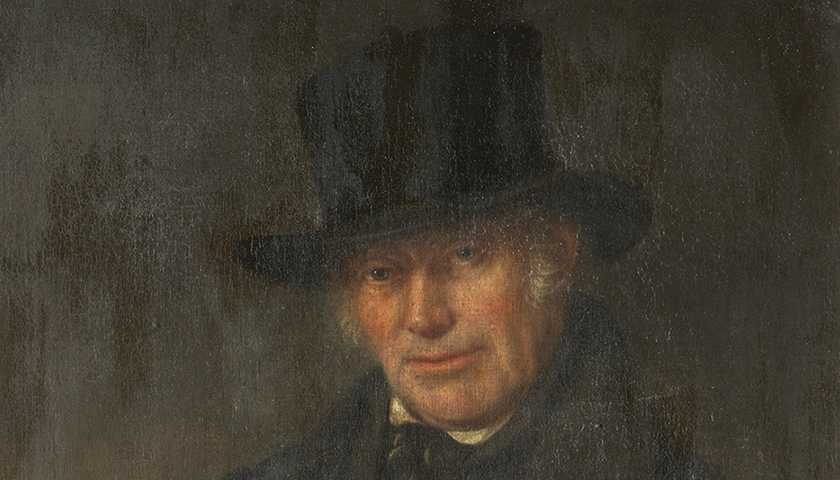
.JPG)

